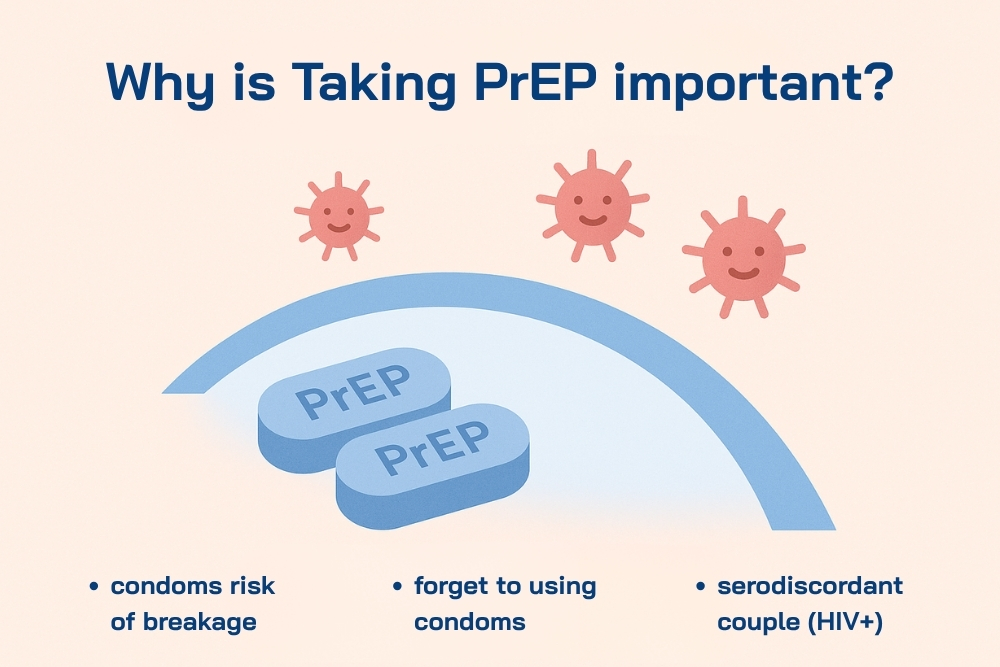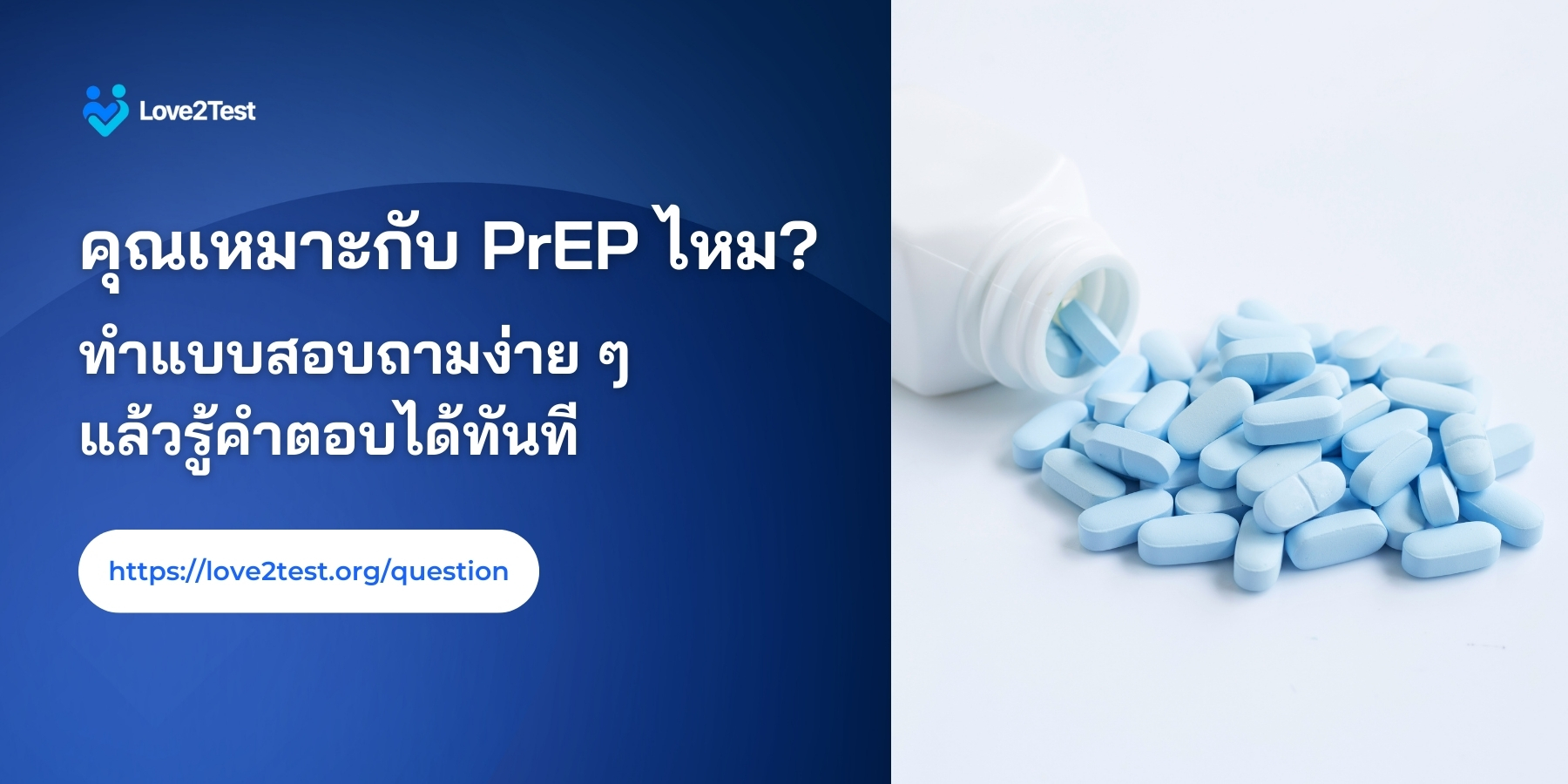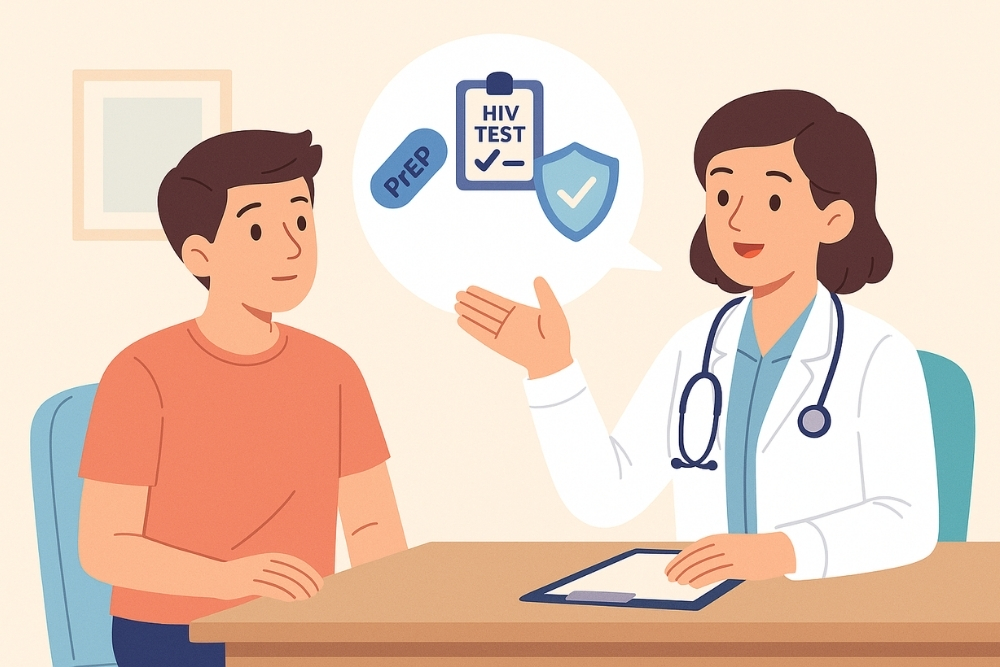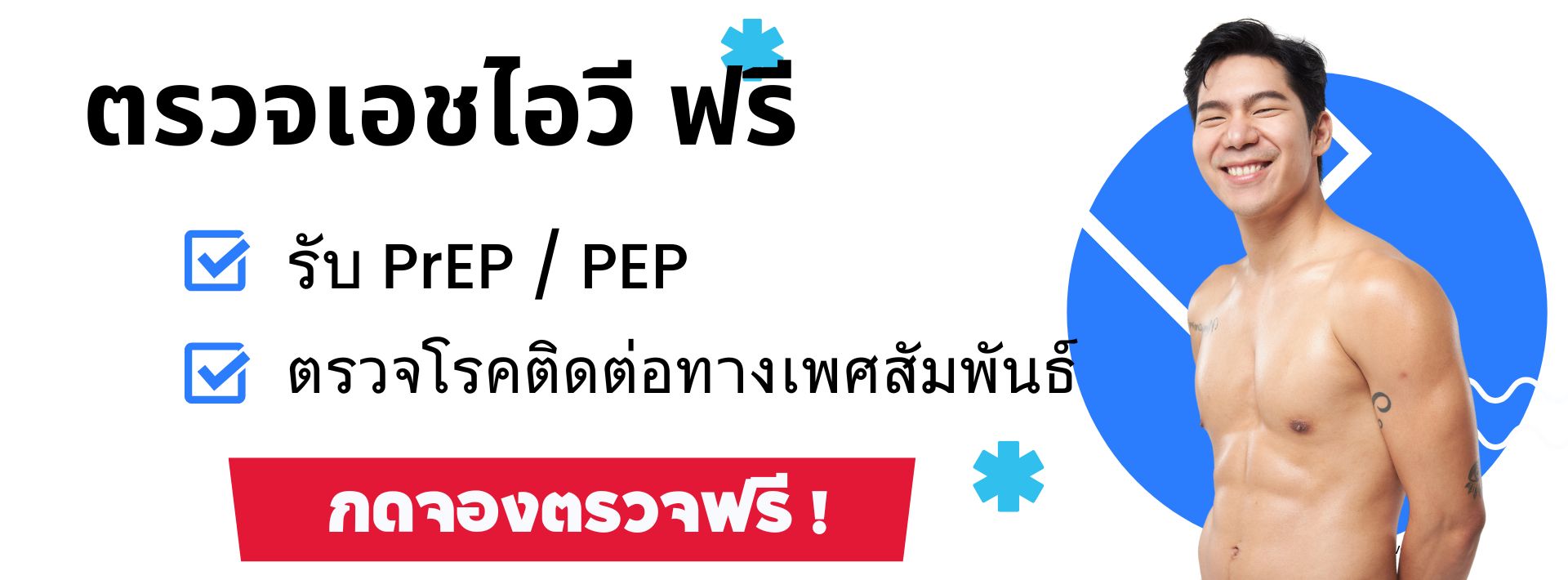Taking PrEP in today’s fast-moving world has become more relevant than ever, as modern relationships and sexual lifestyles continue to evolve. Many people may have heard the term from friends in the LGBTQ+ community or seen it mentioned in health media, but still aren’t sure what it really means, whether it’s truly necessary, or how it connects to HIV prevention. The truth is, HIV is no longer a distant issue. Every year, new infections continue to rise worldwide. Despite ongoing campaigns about using condoms and getting tested, prevention alone is not always enough—condoms can break or slip, some people don’t feel comfortable using them, and sometimes we can’t be sure of a partner’s HIV status.
This is where PrEP plays a vital role. It acts like an extra shield for your body before you’re exposed to risk, serving as an “innovative prevention tool” that allows people—especially the younger generation—to enjoy their sexual lives with more confidence and freedom, without living in fear after every encounter. PrEP isn’t complicated or out of reach; it’s something anyone can access once they understand how to start and use it correctly. In this article, we’ll guide you through PrEP in detail—from what it is, how to begin, to why it’s such an essential part of HIV prevention. Don’t worry, we’ll keep it simple and friendly, like having a chat with a friend, so you’ll get the full picture without needing to open a medical textbook.
What Does Taking PrEP Mean?
The term PrEP stands for Pre-Exposure Prophylaxis, which means “using antiretroviral medication before being exposed to risk” in order to prevent HIV infection. Taking PrEP simply refers to consistently or regularly taking PrEP medication so that your body maintains a sufficient level of protection.

When you have sex without a condom, or when you are at risk of being exposed to HIV through an intimate partner, your body will already have that “protective shield” provided by PrEP. Studies have shown that taking PrEP can reduce the risk of HIV infection by more than 90%.
“Put simply, taking PrEP is like turning on an invisible shield that protects your body all the time.“
Why Is Taking PrEP Important?
Many people have asked, “If condoms can already prevent HIV, why would I need to take PrEP?” The answer is simple: yes, condoms are an excellent method of protection and should always be encouraged, but real life isn’t always as perfect as the theory. Sometimes situations happen that are beyond our control, and that’s where taking PrEP comes in to fill the gap.

- Condoms can fail
- Even if you use them every time, there’s always a risk of breakage, slipping, or incorrect use, which means the protection isn’t 100%. Taking PrEP acts as a backup plan, an added shield of protection in case things don’t go as planned.
- Some people don’t like using condoms
- This is a reality many people don’t openly talk about. Some feel that condoms reduce sensation or make sex less comfortable. In these cases, taking PrEP becomes even more crucial, because it still significantly reduces the risk of HIV when condoms aren’t used.
- Not every situation allows condom use
- Sometimes, intimacy happens unexpectedly or in an environment where using a condom isn’t practical. In those moments, if you’re already taking PrEP, your body has that built-in protection ready, which helps you feel reassured and safe.
Beyond the physical protection, another powerful reason why taking PrEP is so important is the peace of mind it brings. Many people who are on PrEP share that their sex lives have become more free and enjoyable, without the constant anxiety of wondering, “Did I get infected?” after every encounter.
Who benefits most from taking PrEP:
- MSM (men who have sex with men): A group statistically at higher risk of HIV.
- Serodiscordant couples: When one partner is HIV-positive, the HIV-negative partner can maintain a safe and confident relationship by taking PrEP.
- People with multiple partners: The higher the number of partners, the greater the risk, and PrEP provides vital protection.
In short, taking PrEP is not meant to replace condoms, but to work alongside them. Think of it as adding another layer of defense, helping you enjoy your sex life with more freedom, confidence, and safety—all at the same time.

Who Should Consider Taking PrEP?
Although PrEP is a modern and highly effective option for HIV prevention, it doesn’t mean that everyone needs to start using it. The most important step is assessing yourself: “How much risk am I really at?” and “Can taking PrEP help strengthen my protection?”

Many people may feel that condoms alone are enough. But in reality, each person’s behavior and relationships are different. Sometimes condoms are not always used, and sometimes unexpected mistakes happen—such as breakage, slipping, or incorrect use—all of which can increase risk without intention.
This is where taking PrEP comes in as an “extra layer of protection,” helping you feel more confident. It’s especially important for those in higher-risk groups, or for people whose sexual lifestyle may expose them to risks they can’t always control. Choosing to begin taking PrEP isn’t about past mistakes—it’s about looking forward with awareness, and making a conscious choice to protect your health starting today.
So, if you’ve been wondering whether now is the right time to begin taking PrEP, check yourself against these conditions. If any of them apply to you, it’s a strong signal that PrEP may be the right choice to safeguard your future.
1. People who often have sex without condoms
Sometimes we don’t have a condom prepared, or it may feel inconvenient to use one every time. However, unprotected sex is the primary risk factor for HIV infection. If you find yourself in this situation frequently, taking PrEP is a strong additional safeguard.
2. People with multiple sexual partners
Having multiple partners isn’t wrong, but the more partners you have, the higher the chance of encountering someone who is HIV-positive. Taking PrEP acts as a shield that boosts your confidence and significantly lowers your risk.
3. Serodiscordant couples (People Living with HIV)
If your partner is living with HIV, even if they are on treatment and have achieved an undetectable viral load (U=U), taking PrEP as the HIV-negative partner provides extra reassurance and helps the relationship continue smoothly and confidently.
4. People with partners of unknown HIV status
Many relationships start without discussing HIV test results. This creates a kind of “silent risk.” In these cases, PrEP helps you handle uncertainty and reduces unnecessary worry.
5. People diagnosed with or who have had STIs
If you’ve ever been diagnosed with sexually transmitted infections such as gonorrhea, chlamydia, syphilis, or herpes, it’s a sign that your sexual behaviors already put you at higher risk for HIV. PrEP is a proven way to lower that risk.
6. People who use drugs or alcohol during sex
Substances like drugs and alcohol can impair your judgment and self-control, leading to situations where you forget to use a condom or have unprotected sex without planning. In these moments, PrEP acts as a protective barrier, reducing your chances of HIV infection.
How to Start Taking PrEP Step by Step (Practical Guide)
Many people worry that starting PrEP will be complicated, but in reality, it’s a clear and simple process. In fact, many clinics now offer a Same-day Start (screening, assessment, and medication all on the same day). If you’re ready, let’s go through it step by step!

1) Visit a doctor for an HIV test and health screening before starting
The main goal of this step is to confirm that you’re HIV-negative and that your body is ready for the medication. Typically, this includes:
- HIV screening test (If you’ve had a recent risk exposure within 72 hours, tell your doctor—you may need to start PEP first for 28 days, then transition to PrEP).
- Kidney function test (Creatinine/eGFR), since some PrEP drugs are processed through the kidneys.
- Hepatitis B screening (HBsAg, Anti-HBs, Anti-HBc), as some PrEP medications also suppress HBV. If you have chronic HBV, you should never stop PrEP without medical supervision.
- STI screening based on your risk (e.g., gonorrhea/chlamydia with NAAT from throat/rectum/urine, syphilis with RPR/VDRL).
- Pregnancy test for women or anyone with a uterus.
💡 TIP: Choose a clinic where you can return every 3 months for follow-ups. Bring a list of any medications or supplements you’re taking so the doctor can check for drug interactions.
2) Receive the right PrEP prescription for you
The most common regimen is Tenofovir disoproxil fumarate/Emtricitabine (TDF/FTC), one pill per day. Your doctor will recommend the best option depending on your health and lifestyle.
- If you have kidney or bone issues, or known drug allergies, let your doctor know right away.
- Long-acting injectable PrEP is another option (availability may vary). Cabotegravir, for example, can be injected every 2 months, and newer versions under development may last up to 6 months—ideal for people who often forget daily pills.
3) Start Taking PrEP — choose the method that fits your lifestyle
There are two main approaches:
- Daily PrEP (once a day): Simple, no need to calculate timing, and provides continuous protection. Best for those who have frequent sex or unpredictable risk.
- On-Demand PrEP “2-1-1” (for anal sex only, among MSM): Take 2 pills 2–24 hours before sex, then 1 pill 24 hours later, and another 1 pill after 48 hours.
Time to full protection (for daily PrEP):
- For anal sex: about 7 days of daily use.
- For vaginal/front-hole sex: about 21 days of daily use.
👉 During this initial period, use condoms for extra safety and to protect against other STIs.
If you forget a pill:
- If less than ~12 hours late → take it as soon as you remember.
- If much later → skip the missed dose and take the next one on time (don’t double up).
- Set reminders, use a pill organizer, or keep PrEP near daily items (like your toothbrush or keys).
4) Follow up every 3 months — for safety and prescription renewal
Every 3 months (or as advised), you should:
- Repeat the HIV test to confirm you’re still negative.
- Monitor kidney function periodically.
- Screen for STIs according to your sexual activity.
- Discuss side effects, adherence, and future plans with your doctor.
💊 Usually, PrEP is prescribed for 90 days at a time, so schedule your follow-ups in advance.
5) Continue consistently — keep protective levels stable
PrEP works best when taken consistently.
- If you decide to stop PrEP:
- For anal sex protection → continue at least 2 more days after your last exposure.
- For vaginal/front-hole protection → continue for 7 more days after your last exposure.
- Always consult your doctor before stopping, especially if you have chronic Hepatitis B, as sudden discontinuation may cause liver flare-ups.
- Alcohol: No direct interaction with PrEP, but heavy drinking can cause you to forget doses. Plan ahead by setting reminders or carrying extra pills.
- Travel/shift work: Carry PrEP in your hand luggage, adjust for time zone changes, and set temporary alarms on your phone.
Extra Tips to Start Taking PrEP Smoothly
☆ Choose the mode that fits your lifestyle. If you tend to forget easily, go with the daily pill option, or talk to your doctor about long-acting injectable PrEP.
☆ Combine PrEP with condoms and good hygiene. Remember, taking PrEP does not protect against syphilis, gonorrhea, herpes, or HPV. Condoms and regular sexual health check-ups are still necessary.
☆ From PEP to PrEP. If you’ve had a recent risk and started PEP within 72 hours, consult your doctor about transitioning to PrEP after completing the 28-day course to protect yourself in the future.
☆ Always inform your doctor about other medications. Especially drugs that affect your kidneys or bones, as well as any supplements or herbal remedies.
☆ Take care of your kidney and bone health. Stay hydrated, exercise regularly, and follow your doctor’s advice on calcium and vitamin D intake.
The Future of HIV Prevention
Today, PrEP usually means taking a daily pill. But in the near future, we’ll see new options that make HIV prevention even easier and more convenient—especially for those who often forget their medication or don’t want to carry pills every day.
One of the most promising advancements is injectable PrEP, which has already been studied and tested in many countries, including Thailand. The best-known drug is Cabotegravir long-acting (CAB-LA), which is administered as an intramuscular injection every 2 months, eliminating the need for daily pills. Research has shown it to be highly effective at preventing HIV and solving one of the biggest challenges with daily PrEP: forgetting to take it.
Another exciting development is Lenacapavir, a new antiretroviral medication currently in development. Its unique advantage is that it may only need to be injected twice a year. If widely approved, this would be a true game changer, as users would no longer have to worry about strict adherence in their daily routines.
Beyond injections, researchers are also exploring other delivery methods such as PrEP patches, vaginal rings, and subdermal implants. These innovations are designed to give people more choices and allow them to select a method that best fits their lifestyle.
All of these advancements show that taking PrEP is not just a prevention tool for today, but also a “bridge to the future” that brings us closer to the global goal of ending the HIV epidemic. The more diverse, convenient, and accessible prevention methods become, the greater the chance we have to reduce new infections worldwide.
Related Article
- Love2Test Expanding Access to HIV Testing and etc. to End HIV in Thailand
- NHSO Provides PrEP as a Health Benefit
Conclusion
PrEP is not just a medical term or a passing health trend—it is a proven “tool for HIV prevention” that has transformed the lives of many people, helping them feel safer and more confident. Taking PrEP fills the gap where condoms alone may not be enough, easing the fear after sex and allowing people to enjoy their sexual lives with greater freedom and peace of mind.
Most importantly, using PrEP does not mean you are reckless. It reflects that you are “choosing to protect yourself wisely.” Much like health insurance, it doesn’t mean you will definitely get sick, but it ensures you are prepared if risks arise. Daily PrEP has already been proven to be highly effective, and in the future, new options such as PrEP injections every 2 months or even once a year will make prevention even simpler and more convenient. That’s why PrEP is not just a measure for today—it is a “crucial step toward ending the global HIV epidemic.”
So, if you are looking for a prevention method that is practical, effective, and easy to use, ask yourself: “Is it time for me to start taking PrEP?” Or take a quick self-assessment through this link: https://love2test.org/question. Because the decision you make today could be the small step that gives you lifelong confidence and protection.
Reference:
PrEP ป้องกันเชื้อ HIV ได้หรือไม่ แตกต่างจาก PEP อย่างไร?
PrEP (การป้องกันก่อนการสัมผัสโรค) คืออะไร?
รู้ว่าเสี่ยง! คุณก็รับ PrEP – PEP ฟรีได้นะ

